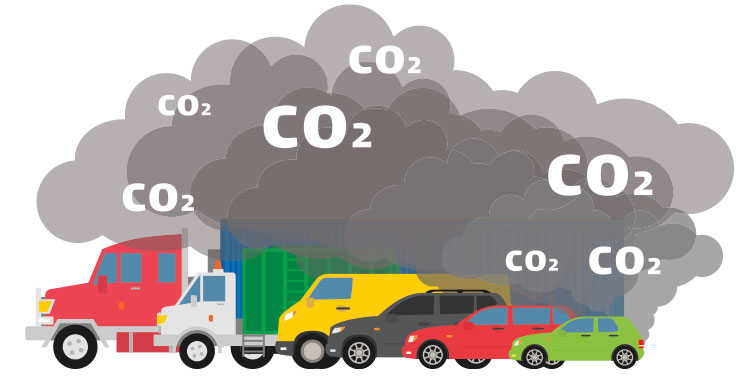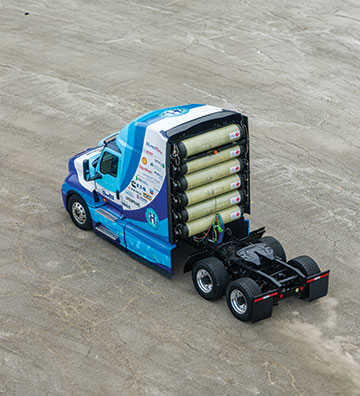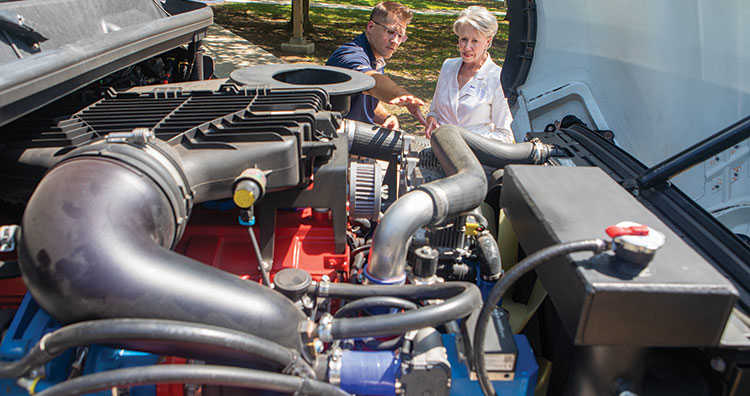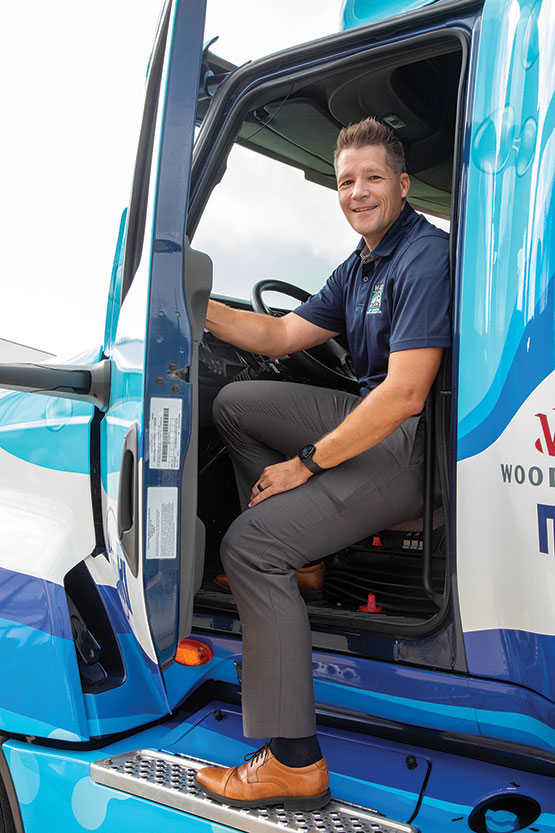Combatting a Warming Climate with ICE
In 2024, extreme weather including deadly heat, flooding, and hurricanes continues to raise alarms about the broader implications associated with rising global temperatures. With 196 nations now party to the Paris Agreement, which seeks to limit global temperature rise to less than 2 degrees, the resolve to combat climate change has never been stronger. Although the exact pathway to accomplishing this objective is far from clear, the commitment to net-zero carbon emissions by 2050 remains the centerpiece of the agreement. This daunting goal means finding carbon-free alternatives for the more than 37 gigatons of CO2 emitted across the globe annually.

In 2022, SwRI launched the H2-ICE consortium to create a heavy-duty tractor-trailer demonstration vehicle using a hydrogen internal combustion powertrain.
The Challenge of Decarbonizing Transportation
The transportation sector remains one of the largest contributors to global CO2 emissions, accounting for nearly a quarter of total emissions, or 8 gigatons. Within the transportation sector, road sources contribute about 75% of these emissions. These include everything from the cars, SUVs, motorcycles and buses that move us around to the pickups, vans and medium- and heavy-duty trucks that transport the goods that we use every day. While we could undoubtedly reduce carbon emissions by doing some of this moving around more efficiently, we will never fully eliminate carbon emissions through efficiency improvements alone. Because it is hard to imagine a world without the ease, convenience and freedom of movement that we enjoy today, the only real solution is to replace all carbon-emitting modes of transportation with zero-CO2 options.
The real challenge here is that pound-for-pound and gallon-for-gallon, it is difficult to match the energy density of hydrocarbon fuels and modern internal combustion engines (ICEs). For transportation to be effective, each vehicle must be able to carry enough energy on-board without the need for constant refueling. To be a viable replacement, any new carbon-free energy source must be as energy-dense, in terms of both weight and volume, as the status quo. For smaller vehicles, the trade-off is less significant, though range anxiety is still a legitimate concern for battery electric vehicles. As vehicle power and distance requirements increase, energy density becomes critical to maintaining vehicle range and cargo capacity. This is especially true in the heavy-duty trucking industry where profit margins are extremely narrow.
Southwest Research Institute has been at the forefront of combustion research and engine development for decades. Over the years, the Powertrain Engineering Division has led consortia, government and commercial projects investigating conventional and unconventional ways of lowering all emissions. The most recent efforts have targeted carbon emissions. While Institute engineers support a range of decarbonization solutions using battery electric, hybrid electric and fuel cell powertrains, recent experience has highlighted the need for a more suitable option to decarbonize heavy-duty vehicles.
A Century of Diesel Dominance
DETAIL
Aftertreatment systems reduce harmful exhaust emissions from internal combustion engines. Various technologies include diesel oxidation catalyst, diesel exhaust fluid, diesel particulate filter, selective catalytic reduction and ammonia slip catalyst systems.
Benz and Daimler debuted the first diesel-powered trucks nearly 100 years ago when they introduced competing vehicles just months apart in April and September of 1923. Gasoline and steam-powered vehicles had been around for a few decades prior, but these new diesel engines were far more powerful and efficient and eventually became the preferred choice for heavy-duty vehicles. After a century of refinement, today’s diesel engines are hardly recognizable from the original designs. With technologies like ultra-high-pressure fuel injection, variable-geometry turbocharging, and advanced model-based control algorithms, modern diesel engines boast more technology than the Apollo rockets that carried the first astronauts to the Moon. Exhaust aftertreatment systems have also evolved alongside the engines to meet increasingly stringent emissions regulations.
In recent years, however, the diesel engine has become a victim of its own success. The relative convenience and low cost associated with moving goods by road has led to an explosion in truck traffic and a subsequent increase in carbon emissions from transportation. Once celebrated as technological marvels of the industrial age, ICEs are now vilified as a symbol of the excesses and environmental exploitation of the modern era. As a result, many countries have announced future bans on ICE sales as the silver bullet solution to decarbonizing transportation.
The specter of ICE bans has led to a surge in research and investment in battery-electric and fuel cell-electric vehicles; however, the transition to these technologies for heavy-duty long-haul trucks presents significant challenges. The primary concern is scalability. A battery for a heavy-duty truck can weigh up to 20,000 pounds, significantly reducing the vehicle’s cargo capacity. Additionally, the current cost of these powertrain options is a substantial barrier to widespread adoption. In response to these significant roadblocks, vehicle manufacturers are revisiting combustion and alternative fuels in search of more practical decarbonization solutions.

The transportation sector is one of the largest contributors to global CO2 emissions, accounting for nearly a quarter of total emissions, or 8 gigatons.
Revisiting Combustion: The Carbon Problem

SwRI has taken a systems approach to lower emissions from diesel engines, applying a variety of techniques and technologies such as ultra-high-pressure fuel injection, variable geometry turbocharging and advanced model-based control algorithms to improve engine performance while decreasing tailpipe emissions.
The primary issue with ICEs isn’t the combustion process itself but rather the carbon emissions produced as an unavoidable byproduct of the hydrocarbon fuels they typically burn. The long chains of carbon molecules that form the backbone of these fuels are the root of the problem. The carbon-to-carbon bonds along these hydrocarbon chains store immense amounts of energy and, without getting too deep into combustion chemistry, the only way to release all that stored energy is to break those bonds apart and form new bonds through the oxidation process that eventually forms CO2. As the carbon molecules break apart, the potential to form other undesirable products like solid carbon soot and carbon monoxide that contributes to air pollution and smog gives the ICE a “dirty” reputation. While these harmful emissions can be readily cleaned up with more efficient combustion and appropriate aftertreatment, it is impossible to escape the CO2 production.
But what if we could retain the power and convenience of combustion while eliminating carbon emissions? What if we simply decarbonize the hydrocarbons themselves?
Enter the Hydrogen Internal Combustion Engine

SwRI has conducted multiyear low-NOx engine research, developing regulatory support for new aftertreatment systems and software and hardware support. NOx is a generic term for the nitrogen oxide emissions associated with air pollution.
Once the carbon chains are removed from a hydrocarbon fuel, what remains are single hydrogen atoms that readily bond to form H2 molecules. As it turns out, these hydrogen-to-hydrogen bonds are even stronger than the carbon bonds, giving hydrogen fuel an energy density approximately three times that of diesel fuel, by mass. Crucially, pure hydrogen combustion produces no carbon emissions, which means no CO2 aside from trace amounts originating from engine lubricants. A hydrogen internal combustion engine (H2-ICE) presents a unique opportunity to harness the benefits of combustion without the environmental drawbacks of hydrocarbon fuels.
Other Benefits of H2-ICE
Apart from the inherent lack of carbon, hydrogen internal combustion engines offer several other intrinsic advantages to decarbonization, including durability and longevity, total cost of ownership (TCO), component compatibility, and retrofit potential.
In terms of TCO, H2-ICE vehicles benefit from decades of cost reductions and optimization of traditional ICEs, making them significantly less expensive than their battery-electric or fuel-cell counterparts. Even with slightly lower operating efficiency, it is projected that an H2-ICE vehicle will have the lowest TCO of all zero-carbon vehicle options. Lower costs will incentivize higher rates of adoption.
DETAIL
Hydrocarbons are organic chemical compounds made up of hydrogen and carbon atoms. Hydrocarbon fuels, derived from fossil sources, include natural gas, propane, butane, gasoline, diesel, kerosene and jet fuel.
About 90% of the components from existing diesel and natural gas engines can be directly applied to H2-ICEs without any modification, and the remaining 10% can be adapted from existing technologies with minor changes to work with hydrogen. This compatibility leverages existing suppliers, logistics, and service networks, facilitating rapid production scale-up and allowing industry to bring these vehicles to market in the numbers needed to reach decarbonization targets.

The transition to hydrogen fuel required a new fuel storage and distribution system. SwRI’s demonstration vehicle also established how long-lasting diesel engines could be retrofitted to run on hydrogen.

The H2-ICE engine in the demonstration vehicle used 90% of components from existing engines, leveraging existing supply chains and service networks to potentially bring these vehicles to market at scales able to affect decarbonization targets.
Because traditional diesel powertrains often last more than 10 years and at least 1 million miles, these vehicles will continue to emit CO2 long after zero-carbon options are available on the market. The potential to retrofit existing diesel engines to run on hydrogen can accelerate the transition to zero carbon vehicles. And in terms of durability and longevity, H2-ICEs are expected to offer the same benefits as traditional diesel engines, making them a robust, reliable option for heavy-duty applications.
Challenges for H2-ICE
H2-ICE vehicles are not without their own challenges. First and foremost, while hydrogen combustion produces no carbon, H2-ICE vehicles cannot currently be classified as zero emissions vehicles. In a perfect world, the only product of hydrogen combustion would be pure H2O; however, just as conventional engines produce some undesirable emissions, H2-ICEs do as well. One of the byproducts of hydrogen combustion is the formation of nitrogen oxides (NOx). In some forms, these compounds have an even stronger greenhouse gas effect than CO2. In other forms and at high enough concentrations, they can lead to air quality degradation and other health risks. NOx has been central to emissions regulations for decades, and current standards allow for only 0.2 grams per horsepower-hour, but some argue that even this is too high for densely populated areas where air quality is already challenged. For H2-ICEs to be recognized as ‘zero-emissions,’ NOx emissions will have to be addressed.
H2-ICE Demonstration
SwRI has explored hydrogen combustion in some detail over the years, initially focused on providing greater energy independence from fossil fuels. More recently, seeing a need for alternative decarbonization strategies, H2-ICE research and development has come back into focus.

SwRI has showcased the H2-ICE demonstration vehicle at major industry trade shows, including the 2024 ACT Expo, the California Hydrogen Leadership Summit and SAE’s COMVEC™ conference.
In 2021, SwRI launched two internal research and development (IR&D) programs aimed at improving H2-ICE power density and thermal efficiency and understanding aftertreatment operation and performance in a hydrogen exhaust environment. Under the first program, we patented a new multimode combustion concept using diesel-like combustion of hydrogen with the assistance of a spark-ignited pilot flame to eliminate abnormal combustion events. Under the second program, engineers discovered some very interesting catalytic behavior from traditional aftertreatment systems in the presence of hydrogen. These programs provided a perfect platform to discuss H2-ICE development with other experts across the industry and establish our capabilities in the H2-ICE research community, laying the groundwork for additional research.
In November 2022, SwRI established the H2-ICE consortium, a collaborative initiative aimed at demonstrating the potential of hydrogen-fueled internal combustion engines to reduce CO2 and other harmful emissions while retaining the benefits of traditional ICEs. Supported by a membership consisting of 20 engine and vehicle manufacturers, component suppliers and energy providers, the SwRI team worked to convert an existing 15L natural gas engine to run on hydrogen. The work leveraged the previous IR&D to develop combustion and aftertreatment systems capable of meeting the consortium targets of high efficiency and ultra-low emissions. Consortium members provided both financial support for the engineering effort as well as in-kind contributions of essential components for the program.
DETAIL
The Environmental Protection Agency and the California Air Resources Board are national and state entities regulating emissions. EPA and CARB aligned their 2027 targets for tailpipe nitrogen oxides, or NOx, emissions, which call for 0.035 grams per horsepower hour during normal operations, 0.05 grams at low load, and 10 grams at idle.
The consortium’s efforts culminated in the completion of a Class 8 heavy-duty H2-ICE demonstration vehicle. The 370-horsepower hydrogen-fueled internal combustion engine showed a 99.7% reduction in CO2 emissions compared to a similar diesel engine. Additionally, tailpipe NOx emissions from the reconfigured aftertreatment system were lower than both EPA/CARB 2027 NOx targets as well as the voluntary ultra-low emissions standard over all regulatory test cycles.
SwRI has showcased the demonstration vehicle at major industry trade shows, including the 2024 ACT Expo, the California Hydrogen Leadership Summit and SAE’s COMVEC™ conference. These events provide an opportunity to present the technology to legislators, policymakers and fleet operators, highlighting the viability and benefits of H2-ICE as a sustainable solution for heavy-duty transportation.
The Road Ahead
Hydrogen internal combustion engines hold significant promise in the path toward decarbonizing transportation. Through the ninth phase of its long-running “clean diesel” collaborative program, SwRI’s Clean Highly Efficient Decarbonized Engines (CHEDE-9) consortium will continue to advance our fundamental understanding of H2-ICE combustion. By harnessing hydrogen’s potential, we can address the challenges of heavy-duty transportation and contribute to a more sustainable future.
The future of decarbonized transportation cannot be confined to a single solution. While battery-electric vehicles and fuel cells play crucial roles in reducing carbon emissions, hydrogen internal combustion engines offer a complementary and scalable solution, particularly for heavy-duty applications. As we continue to innovate and collaborate, the path to a cleaner, cooler world becomes clearer, with H2-ICE leading the transition to a broader hydrogen economy.
Questions about this story or Hydrogen Internal Combustion Engine (H2-ICE) Consortium? Contact Ryan Williams at +1 210 522 5158.

ABOUT THE AUTHOR
Ryan Williams, a specialist in advanced diesel and spark-ignited engines, manages SwRI’s Engine Systems Research & Innovation Section. As the program manager of the H2-ICE consortium, he led the joint SwRI-industry team that developed the Class 8 heavy duty H2-ICE demonstration vehicle now touring the U.S.

